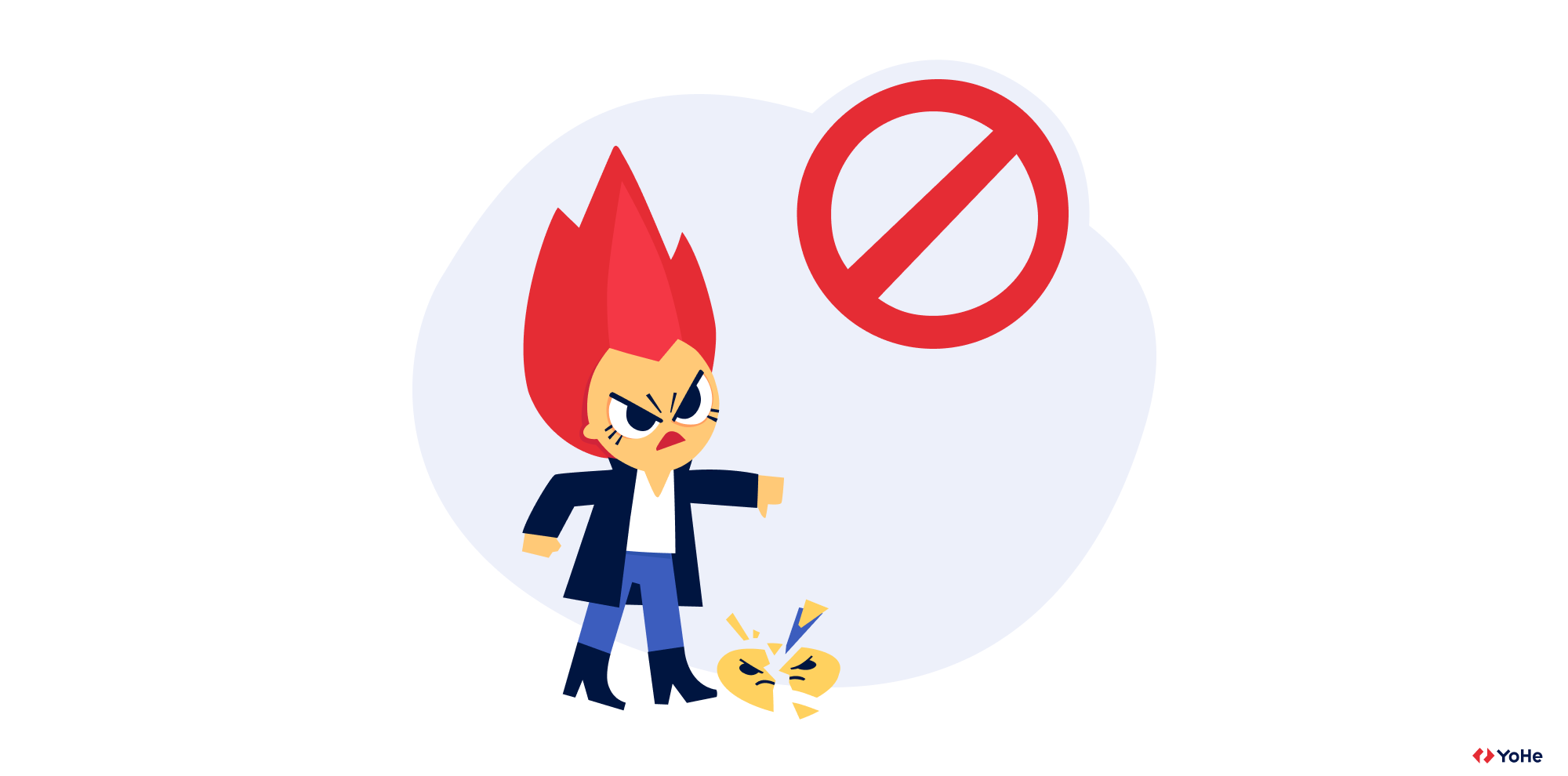With Net Promoter Score, you can literally calculate customer loyalty. In this article, let's discuss how NPS will help your company grow.
What is NPS?
Net Promoter Score is an index of customer loyalty. A metric shows a customer's attitude to your product or website and helps discover how likely they are to recommend you to their friends or relatives.
NPS is measured to improve customer loyalty. It differs from many other metrics in that it learns the overall impression of a company or brand and not about individual sections of the user path.
Is loyalty that important?
To explain why customer loyalty is so important, let's start from afar. In the 90s of the XX century, the growth of the American company AOL was rapid. The Internet giant provided access to the network to almost half of US households. In addition, it owned popular content platforms, a browser, and an email service.
But instead of gaining a foothold in the market and retaining loyal customers, America Online invested more and more money in promoting and winning new users. As a result, the company's operating systems could not stand it. And the nickname America On Hold stuck to America Online for many years due to constant network outages, sometimes lasting for several days.
Even its adherents began to turn away from the company. During the year 1999, the outflow of customers amounted to 72% (!), and in the long term, the company missed the chance to become an equal competitor to Google. If in the early 2000s AOL's capitalization was still higher than that of the future search giant, then in 2017, AOL was estimated at $ 4.5 billion, and Google at $ 850 billion. It is clear that the 1000 and 1 factors led to such a difference, but you can't deny that the failure in the late 90s hit the company's reputation hard.
How could AOL avoid a similar fate? The American company was quite a bit unlucky – if that disaster had happened a few years later, it would have had a chance to notice an impending cloud. Because in 2003, the business strategist Frederick Reichheld together with the marketing monsters from Bain & The Company, conceptualized a new metric for analyzing customer relationships – the Net Promoter Score.
Subsequently, Reichheld wrote the article "One Number You Need to Grow" in the Harvard Business Review magazine. After that, the world learned about the tool that takes the company-client relationship to a new level.
Why is it important to measure the Net Promoter Score?
According to Nielsen research, 83% of respondents trust the recommendations of family members and friends more than any other form of advertising. Even one dissatisfied loyal customer can cost you several new ones at once! Such a user is also almost 5x times cheaper than a new one and is likely to return for purchases or clicks.
That's not all! Bain Research & The Company showed that reducing the outflow of customers by only 5% increases revenue by 25-95%. So the ROI of working with loyal customers is even higher than similar to attract new customers.

It is no coincidence that in 15 years, the NPS has grown into a whole system. Today, the Net Promoter Score is measured by the largest companies in the world, including Apple, Microsoft, eBay, PayPal, and Western Union.
The big plus of NPS is that it is super simple to measure. You can even do this offline – give the client a tablet with estimates or print them out on paper. If you exist on the Internet, you have to learn how to interview users at the right time and in the right place.
How to measure NPS?
To measure the Net Promoter Score, you need to ask customers: "How likely are you to recommend our business to a friend or colleague?" Please note that this question is the only possible and canonical for NPS. Frederick Reichheld tried dozens of options on various companies, but only this formulation allowed him to receive the largest number of responses.
Users answer the question with a score on an 11-point scale – from 0 to 10. And one more note: often, when creating such surveys, other types of scales are used, for example, from 1 to 5. But such a metric also cannot be considered NPS.
The clients who have rated are divided into groups:
Critics (score 0-6) are dissatisfied customers who can bring you to sleepless nights and a couple of hair pulled out. They slow down the brand growth and launch word of mouth with unpleasant details about your site/product.
Neutrals (score 7-8) are usually satisfied but disinterested customers. They will ignore the offers, and the probability of their return to the site is 50/50. In addition, they can easily switch to competitors.
Promoters (rating 9-10) are loyal and so satisfied customers they will not only return to the site / buy more but also with a high probability will bring a couple of friends.
Now it is simple to calculate the Net Promoter Score:
The total percentage of critics – total percentage of promoters = NPS.

For example, 2,000 people took part in your survey. 600 of them (30%) rated from 1 to 6 points, 400 – 7 or 8, and 1000 clients (50%) – 9 or 10. NPS is 50%-30% – 20 points.
Another example. 5,000 clients participated in the survey. 3,500 of them (70%) were critics, 500 were neutrals, and 1,000 (20%) were promoters. The NPS will be negative since 70% must be subtracted from 20%. That is, the Net Promoter Score, in this case, is equal to -50 points.
Thus, the NPS can range from -100 to 100. If NPS is -100, all your customers are critics, and if +100 – they are promoters. However, there are practically no ideal situations. On average, 30 points is already a decent result, and 70 can be considered outstanding.
What is the NPS to aim for?
Some statistics from Temkin Group Research:
The probability that the promoters will buy again is 5x times higher than for all other users.
Promoters are 7x times more likely to forgive some of your mistakes than others.
Promoters are open to new offers. They try something new 9x times more often than others.
Therefore, any business should strive to increase the percentage of promoters. An NPS slightly above zero means that you still have a lot of work to do to improve customer service, but you are on the right track – your users are more happy than unhappy. If the score is more than 50, you will feel the work of word of mouth. Loyal customers will bring new leads, and your growth rate will increase. When the NPS approaches 75, know that your level is God, and users adore your company!
However, in the real world, it is almost impossible to achieve 75+. In addition, it all depends on the scope of your business. The higher the competition in the industry, the lower the average rating, even for top companies. For example, 0 is good for banking, and 40 is low for Internet service. And the more often a person uses your service or product, the higher his expectations, and the worse the estimates. And this should also be taken into account when analyzing the Net Promoter Score.
What to do with NPS next?
NPS is not a unique metric that has no disadvantages. Opponents argue that the Net Promoter Score is difficult to predict, it is less accurate than surveys, and does not yet explain the behavioral characteristics of loyal customers.

However, this metric is not initially intended to explain user habits. To get benefits from the NPS, you need to add at least one clarifying open-ended question to the questionnaire. Here are some examples:
- What is the main reason for your rating?
- How could we improve your experience?
- What features of the product/service do you use the most?
- What was missing or upsetting when interacting with our company?
High-quality feedback will help identify the pain points of customers. And improve their user experience. For example, Airbnb, together with NPS, analyzes reviews of apartments. The company found that promoters are 13% more likely to book accommodation for the second time and 4% more likely to invite friends to the service than critics. Accordingly, now with the help of NPS, Airbnb can predict trends in rebooking and referral programs.
Therefore, even if you started using NPS and (hopefully) saw many promoters do not stop working! Initiate a dialogue with happy customers and convince them to participate in the referral program. So NPS will turn you from just a metric into a whole system for attracting new users and working with loyal customers.






